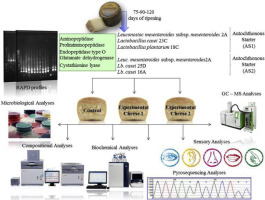Food Research International ( IF 7.0 ) Pub Date : 2018-10-09 , DOI: 10.1016/j.foodres.2018.10.024 Ilaria De Pasquale , Raffaella Di Cagno , Solange Buchin , Maria De Angelis , Marco Gobbetti

|
The use of selected autochthonous mesophilic lactic acid bacteria as starter cultures was investigated according to the traditional protocol for making Pecorino Crotonose (PC). Leuconostoc mesenteroides subsp. mesenteroides 2A, Lactobacillus casei 23C and Lactobacillus plantarum 18C (Autochthonous Starter, AS1) and Leuc. mesenteroides subsp. mesenteroides 2A, and L. casei 25D and 16A (AS2) were isolated and identified from aged ewes' milk PC cheeses, selected based on several enzymatic activities, and used as starter cultures. As shown by the in vitro kinetic of acidification, selected starter cultures had suitable capabilities to acidify. The manufacture of PC cheeses was carried out at an industrial plant scale. A control cheese (CC) was also made, using commercial starters consisting of mesophilic and thermophilic species. Ripening lasted 105 days at 10 °C. A poly-phasic approach was used to compare cheeses during manufacture and ripening, mainly based on pyrosequencing of the 16S rRNA targeting DNA, proteolysis and volatile component analyses. Compared to CC, both autochthonous starter cultures slightly affected the gross chemical composition of PC cheese. The cell density of thermophilic starters of CC progressively decreased throughout ripening. Plate count and RAPD-PCR showed that the cell number of autochthonous lactobacilli cultures of PC cheeses, made with AS1 and AS2, was almost constant throughout ripening and abundantly higher than that observed in CC. As shown by culture-independent analysis, the OTUs found during ripening varied depending on the manufacture with or without autochthonous starter cultures. The major chemical differences among cheeses were the concentration of free amino acids and the synthesis of some key volatile components (e.g., 2-methyl-1-propanol, 2-methyl-1-butanol, isobutyric, isovaleric, and isocaproic acids). Compared to CC, the use of AS1 positively affected the overall cheese quality.
中文翻译:

土生嗜温乳酸菌作为发酵培养百克力诺巴豆奶酪的发酵剂的使用:对成分,微生物和生化特性的影响
根据用于制备Pecorino巴豆糖(PC)的传统协议,研究了选择的土生嗜温乳酸菌作为发酵剂的用途。肠膜明串珠菌亚种。mesenteroides 2A,干酪乳杆菌23C和植物乳杆菌18C(Autochthonous Starter,AS1)和Leuc。肠膜肠杆菌亚种 mesenteroides 2A和干酪乳杆菌从陈年母羊的牛奶PC奶酪中分离并鉴定出25D和16A(AS2),并根据几种酶促活性进行选择,并将其用作发酵剂。如体外酸化动力学所示,所选的发酵剂培养物具有合适的酸化能力。PC奶酪的生产是在工厂规模内进行的。还使用由嗜温和嗜热菌种组成的商业发酵剂制作了对照干酪(CC)。在10°C时,成熟持续105天。多阶段方法主要是基于靶向DNA的16S rRNA的焦磷酸测序,蛋白水解和挥发性成分分析,采用多阶段方法比较制造和成熟期间的干酪。与CC相比,两种自发发酵剂文化对PC奶酪的总化学成分都有轻微的影响。CC的嗜热起始物的细胞密度在整个成熟过程中逐渐降低。板数和RAPD-PCR表明,用AS1和AS2制成的PC干酪的本地乳杆菌培养物的细胞数在整个成熟过程中几乎是恒定的,并且比在CC中观察到的要高得多。如独立于培养物的分析所示,在成熟过程中发现的OTU随有或没有自发发酵剂培养物的制造而变化。奶酪之间的主要化学差异是游离氨基酸的浓度和一些关键的挥发性成分(例如2-甲基-1-丙醇,2-甲基-1-丁醇,异丁酸,异戊酸和异辛酸)的合成。与CC相比,AS1的使用对总体奶酪质量产生了积极影响。板数和RAPD-PCR表明,用AS1和AS2制成的PC干酪的本地乳杆菌培养物的细胞数在整个成熟过程中几乎是恒定的,并且比在CC中观察到的要高得多。如独立于培养物的分析所示,在成熟过程中发现的OTU随有或没有自发发酵剂培养物的制造而变化。奶酪之间的主要化学差异是游离氨基酸的浓度和一些关键的挥发性成分(例如2-甲基-1-丙醇,2-甲基-1-丁醇,异丁酸,异戊酸和异辛酸)的合成。与CC相比,AS1的使用对总体奶酪质量产生了积极影响。板数和RAPD-PCR表明,用AS1和AS2制成的PC干酪的本地乳杆菌培养物的细胞数在整个成熟过程中几乎是恒定的,并且比在CC中观察到的要高得多。如独立于培养物的分析所示,在成熟过程中发现的OTU随有或没有自发发酵剂培养物的制造而变化。奶酪之间的主要化学差异是游离氨基酸的浓度和一些关键的挥发性成分(例如2-甲基-1-丙醇,2-甲基-1-丁醇,异丁酸,异戊酸和异辛酸)的合成。与CC相比,AS1的使用对总体奶酪质量产生了积极影响。在整个成熟过程中几乎保持恒定,并且比在CC中观察到的要高得多。如独立于培养物的分析所示,在成熟过程中发现的OTU随有或没有自发发酵剂培养物的制造而变化。奶酪之间的主要化学差异是游离氨基酸的浓度和一些关键的挥发性成分(例如2-甲基-1-丙醇,2-甲基-1-丁醇,异丁酸,异戊酸和异辛酸)的合成。与CC相比,AS1的使用对总体奶酪质量产生了积极影响。在整个成熟过程中几乎保持恒定,并且比在CC中观察到的要高得多。如独立于培养物的分析所示,在成熟过程中发现的OTU随使用或不使用本地发酵剂培养物的制造而变化。奶酪之间的主要化学差异是游离氨基酸的浓度和一些关键的挥发性成分(例如2-甲基-1-丙醇,2-甲基-1-丁醇,异丁酸,异戊酸和异辛酸)的合成。与CC相比,AS1的使用对总体奶酪质量产生了积极影响。奶酪之间的主要化学差异是游离氨基酸的浓度和一些关键的挥发性成分(例如2-甲基-1-丙醇,2-甲基-1-丁醇,异丁酸,异戊酸和异辛酸)的合成。与CC相比,AS1的使用对总体奶酪质量产生了积极影响。奶酪之间的主要化学差异是游离氨基酸的浓度和一些关键的挥发性成分(例如2-甲基-1-丙醇,2-甲基-1-丁醇,异丁酸,异戊酸和异辛酸)的合成。与CC相比,AS1的使用对总体奶酪质量产生了积极影响。











































 京公网安备 11010802027423号
京公网安备 11010802027423号